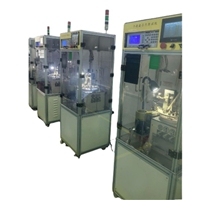In electronics manufacturing, sorting chips accurately is crucial for product quality and operational efficiency. While manual sorting has been a traditional method, it comes with significant challenges. Chip sorting machines offer a modern solution, helping manufacturers save both time and costs while improving precision.
Challenges of Manual Chip Sorting
Manual chip sorting relies heavily on human labor. Workers must visually inspect and separate chips based on quality grades, which is time-consuming and prone to errors. Sorting even a small batch manually can take hours, slowing down production and increasing the risk of inconsistencies.
Labor costs for manual sorting are also significant. Factories need to hire more staff to handle larger volumes, and employee fatigue can further compromise accuracy. Additionally, mistakes in sorting may lead to defective products reaching assembly lines, resulting in waste, rework, and delays. These factors make manual sorting inefficient for factories aiming to optimize production and reduce operational costs.
Advantages of Chip Sorting Machines
Chip sorting machines are designed to automate the sorting process, delivering consistent results at high speeds. Horle’s chip sorting machines, for example, can process 50–60 pieces per minute, sorting chips with precision according to 0.5%, 1%, and 2% grades. This level of accuracy ensures that only the right-quality chips move forward in the production line, reducing waste and defects.
Automation also minimizes human error. Unlike manual sorting, machines provide uniform performance regardless of the batch size or production schedule. Factory staff can focus on other value-added tasks, while the machine handles repetitive sorting efficiently.
Cost Savings Comparison
Investing in a chip sorting machine leads to measurable cost savings over time. Manual sorting requires a large workforce, contributing to higher labor costs. Over months and years, these expenses accumulate, especially for high-volume electronics production.
In contrast, a chip sorting machine reduces the need for additional staff, lowering wages and associated benefits. Maintenance and operational costs for machines are predictable and generally lower than the ongoing expenses of manual labor. By increasing sorting accuracy and reducing defects, factories also save money on materials that would otherwise be wasted due to errors.
Chip Sorting Machine Manufacturer in China
Time Savings and Improved Production Efficiency
Time is a critical factor in electronics manufacturing. Manual sorting slows down production lines, creating bottlenecks and delaying shipments. Chip sorting machines dramatically increase throughput by handling dozens of chips per minute without compromising accuracy.
Faster sorting accelerates overall production cycles, enabling factories to meet tight deadlines and manage larger orders efficiently. By reducing the time spent on repetitive tasks, manufacturers can allocate resources more effectively, improving productivity across the entire facility.
Why Choose Horle’s Chip Sorting Machines
Horle’s chip sorting machines stand out for their reliability, precision, and ease of use. Built to handle high-volume production, these machines provide consistent sorting based on multiple quality grades, helping manufacturers maintain strict quality standards.
Maintenance is simple, and the machines are designed for long-term durability, reducing downtime and service costs. As a global supplier, Horle supports electronics manufacturers worldwide, ensuring that factories have access to advanced sorting solutions tailored to their needs.
Conclusion
Switching from manual sorting to a chip sorting machine brings clear advantages in cost savings, time efficiency, and product quality. For factories and electronics manufacturers looking to streamline operations and boost productivity, investing in a Horle chip sorting machine is a practical and profitable choice.
Automated sorting ensures accurate grading, reduces labor costs, and accelerates production, giving manufacturers a competitive edge in the fast-moving electronics industry. By making the transition, companies can focus on growth, innovation, and delivering higher-quality products to their customers.








